Intel Core Duo: AOpen i975Xa-YDG to the Rescue
by Gary Key on May 4, 2006 8:00 AM EST- Posted in
- Motherboards
Audio Performance
We limited audio testing to the Rightmark 3D Sound version 2.2 CPU utilization test and tested with sound enabled to show the performance effects on several games. The Rightmark 3D Sound benchmark measures the overhead or CPU utilization required by a codec or hardware audio chip.
The Realtek ALC-880 HD audio codec on the AOpen board was tested with the recently released 1.36 driver set. The Realtek DirectSound audio drivers do not support more than 32 hardware buffers and the OpenAL 1.1 drivers do not support more than 30 hardware buffers at this time so the scores cannot be directly compared to the Creative Labs Sound Blaster X-Fi cards in the benchmarks.
It is interesting to note the reduced CPU utilization with the Core Duo or Opteron 165 as the load is balanced between each processor with the Realtek 1.36 drivers and the Creative drivers to a certain extent. However, these CPU utilization rate improvements with the dual-core setup does not have any bearing on actual game benchmarks as the reduction in frame rate percentages are the same as our single core score.
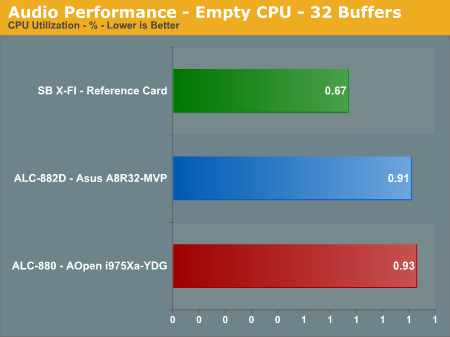
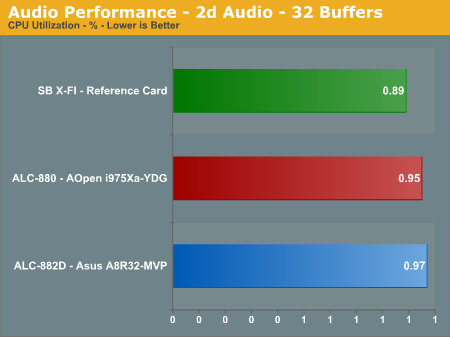
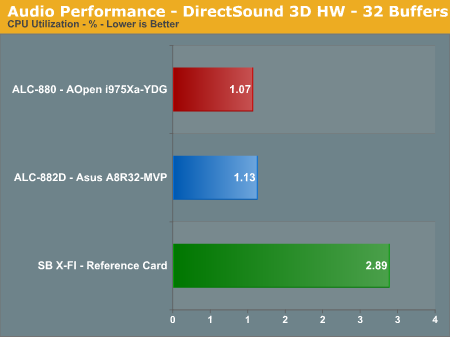
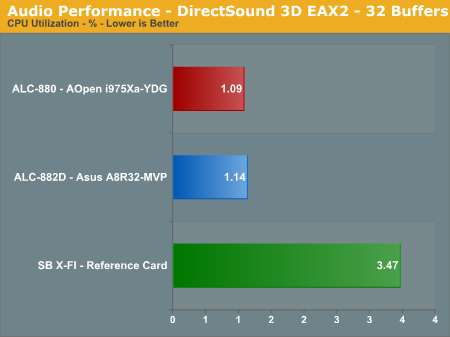
The Realtek ALC-880 codec offers very competitive CPU utilization rates when compared to the Realtek ALC-882 on the Asus board. The ALC-880 generates significantly better audio quality than the AC97 based systems and very similar audio quality to the ALC-882 solution. The ALC-880 was released before the ALC-882 but has nearly the same audio quality and performance in our testing. Our subjective headphone testing revealed a slight difference between the two codecs, with the output from the ALC-882 sounding clearer in the treble and mid-range tones. However, the difference was negligible when utilizing our 4, 5.1, or 7.1 speaker setup in a typical room environment. The Sound Blaster X-Fi has the lowest overall CPU utilization (single core systems) with the ALC-880 and the ALC-882 following closely. Let's find out how these results translate into real world numbers.
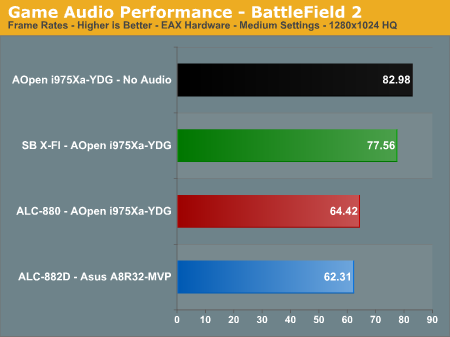
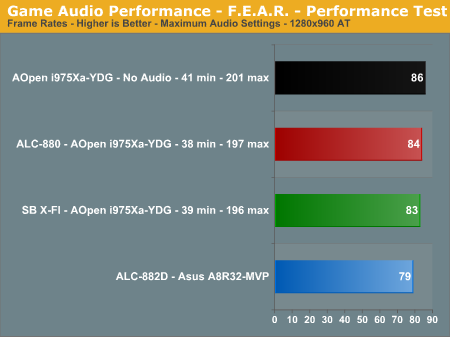
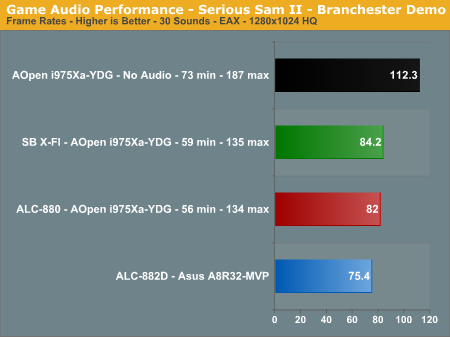
The audio performance numbers remain consistent as the Realtek ALC-880 consistently finishes near the SoundBlaster X-Fi in the benchmarks. Serious Sam II has an average loss of 37%, Battlefield 2 at 28%, and F.E.A.R. at 2%. F.E.A.R. is extremely GPU limited so the CPU has additional cycles to generate the audio streams required by the Realtek drivers.
The overall output quality of audio with the Realtek ALC-880 ranks with the ALC-882/883 series as the best of the on-board HD audio solutions we have heard to date, while performance continues to improve with each driver release. The vast majority of users should have no issues utilizing the ALC-880 as their primary audio solution considering the quality of audio and performance at this time in most applications.
Obviously, if you are a serious gamer, then a dedicated sound card is still useful to ensure consistent frame rate averages across a wide variety of games, and in the case of the Sound Blaster X-Fi, you also get improved audio quality and EAX3/4/5 support. If you'd like more details on the Realtek solution, you can refer to the Realtek ALC-880 Specifications.










81 Comments
View All Comments
Per Hansson - Wednesday, May 17, 2006 - link
Hi Gary, just wanted to drop in and give you a kudos on this very nice review!It also makes me smile to finally see Intel catching up with AMD, this can only be good news for the customer...
And a small heads up, there are a few Intel Core Duo Engineering sample CPU's on sale at eBay, "hint hint engineering sample=multipler unlocked"
And also a big thanks for finally posting those capacitor shots and mentioning them, keep up the good work!
Also I think Aopen deserves recognition for designing a mainboard with so high-quality components, Rubycon=Way to go!!!
goinginstyle - Friday, May 19, 2006 - link
Agreed....
vailr - Thursday, May 4, 2006 - link
Updated driver:(from: http://www.station-drivers.com/page/intechip.htm)">http://www.station-drivers.com/page/intechip.htm)
Intel Chipset software Installation Utility
Version 7.3.1.1013 - Windows 2000/XP 32/64bits/2003Server Multi Langues & officiel
ftp://aiedownload.intel.com/df-support/10392/eng/i...">ftp://aiedownload.intel.com/df-support/10392/eng/i...
Version 8.0.0.1005 Alpha
Windows 2000/XP 32/64bits/2003Server Multi Langues & non officiel
http://www.station-drivers.com/telechargement/inte...">http://www.station-drivers.com/telechargement/inte... Alpha.exe
Gary Key - Thursday, May 4, 2006 - link
Thank you for posting these links. :) We have a policy of utilizing the latest driver sets on a supplier's website at the time our testing starts, in this case the Intel general download page is still posting the 7.2.2.1006 driver set. However, I am using the 7.3.1 driver set on our retail board sample tonight. ;-)irev210 - Sunday, May 7, 2006 - link
Hello Gary,Sorta funny how that other fellow has absolutely no idea what he is talking about.
I just wanted to touch upon something that I didnt see get much attention.
You should have mentioned in your article about how efficient the core architecture is, and how well it scales with increased frequency. The chip turns into a total monster once you get past 3ghz, and continues to perform better and better as you increase the speed. The fastest I could get on air was around 3.1ghz. I wouldnt be afraid to crank the volts to the 1.5 max on the aopen board... with a different cooler, you should hit some nice speeds. Try swapping out for a zalman 9500, or a big typhoon.
The shortfalls, are as you mentioned the southbridge lacking raid, and the poor bios options. Vcore should let us up to 1.65-1.7, while Vdimm should let us do atleast 2.3.
While this may not satisfy the most serious enthusiast, this board does fill a nice niche. The price is pretty high, but core duo CPU's can be had on the cheap, which makes up for it. For someone that is worried about their electric bill, and wants performance and performance per watt, this is a great alternative.
For others who must have the fastest. This just makes them drool. This is the low end of the core architecture. Merom and Conroe to follow... we shall be stunned.
Consdering Meroms being tested now at 3.0Ghz are faster than 3.2Ghz Yonah's... AND YOU WILL SEE Conroe EE at 3.33 w/ a 1333fsb doing 4ghz w/ 1500mhz FSB :)
For those that dont get it yet... AMD will need a AM2 processor running at about oh 4.8Ghz to beat a 4Ghz clocked conroe :)
Good things to come. I take no sides, im just excited about new stuff :)
Marlowe - Thursday, May 4, 2006 - link
How come a ~1 % cpu usage translates into a massiv 20 fps drop in BF2? Looks like EA have a deal with Creative :(A lot of world records have been beaten with this mobo already over here at XS :)
coolaler even got SLI enabled on it ;) also running a merom in it ;)
Your 266 FSB is very good and about normal for aircooling. Give it some cold and it will go further ;)
Frumious1 - Thursday, May 4, 2006 - link
[font color="#000000] (Damn white text. Nice comment engine AnandTech.... Need a new programmer?)Because RightMark is a theoretical test and not actually a real game or audio application. Also, look at the 3D/EAX scores - it's more than 1% CPU usage, but still less than 20% or whatever.
Gary Key - Thursday, May 4, 2006 - link
It has to do with the Realtek driver load and Creatives to some extent being split between the cores during the RightMark testing. I noted in the text that although the cpu utilization is extremely low in our Rightmark results due to the load balancing that the actual game results (percentage differences) were basically the same as our single core scores. The drop in BF2 is due to the audio algorithms being generated by the CPU rather in hardware as on the X-FI card. Our audio settings in BF2 are set to hardware, medium quality, EAX enabled, the high quality setting extracts another 6FPS but we generally have not noticed an increase in audio quality. This is one penalty you pay for on-board audio in a CPU limited game although Serious Sam II is the one exception for either solution.
We are hoping to receive a T2700 chip from Intel shortly and will "chill" it to see what results come from it. :) Yes, we had SLI working on the board also, but that is a topic that will be buried with Jimmy Hoffa at this time. ;-)
NT78stonewobble - Friday, May 5, 2006 - link
Intriguing last 2 sentences.The comments section has some really good info alot of the time :).
And kudos for bringing into the review something about the penalty for using onboard audio versus dedicated hardware.
You're not by any chance planning on writing something about audio quality some-time? Not that im an audiophile or the like, just curious.
Gary Key - Friday, May 5, 2006 - link
We will expand our audio section in the next update to our motherboard review section. We are looking at several variations of the review process as we enter a very busy time of the year with AM2, Conroe, and others all launching over the next 90 days. :)